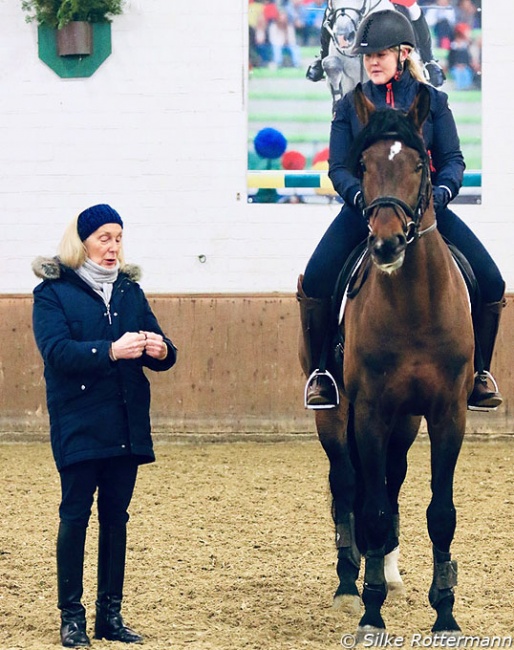
I have regularly trained with Col. Christian Carde in my own country and abroad from 2013 to 2018, so I am pretty well acquainted with French classical riding. When Carde decided to stop clinics abroad, I was very lucky to know to who to turn to continuing my classical riding education because as a riding instructor my focus is on finding solid tools working with every horse. And classical riding principles, may they be French or German, do exactly this job.
I’ve have had the opportunity before to ride in three weekend clinics on borrowed horses with former German I-judge Angelika Frömming the years before, but after the last clinic in September 2019 the wish became stronger to intensify training with her. Having lost both my horses in 2019, the problem seemed to get a four legged partner to realize my wish for getting to know more about classical German equitation. Thanks to the incredible kindness of Mr. Hannes Müller, head of the German Riding School since 1997, the opportunity arose to get two well trained horses of the School to ride for my training stay in Warendorf.
So January 2020 I flew out from Helsinki to Düsseldorf and took two trains to bring me to Germany’s equestrian capital near Münster.
First Day: Getting Acquainted with New Horses
In the morning Mrs. Frömming picked me up at the nice little B&B where I had already been staying earlier to take me to the German Riding School which is located in the middle of Warendorf, just next to the State Stud and both work closely together. The German Riding School is over 60 years old and since then has seen countless future riding instructors passing their written and ridden examinations on the well schooled school horses. They are stabled in the historic stables close to the big indoor arena that is attached to the administration building of the German Riding School.
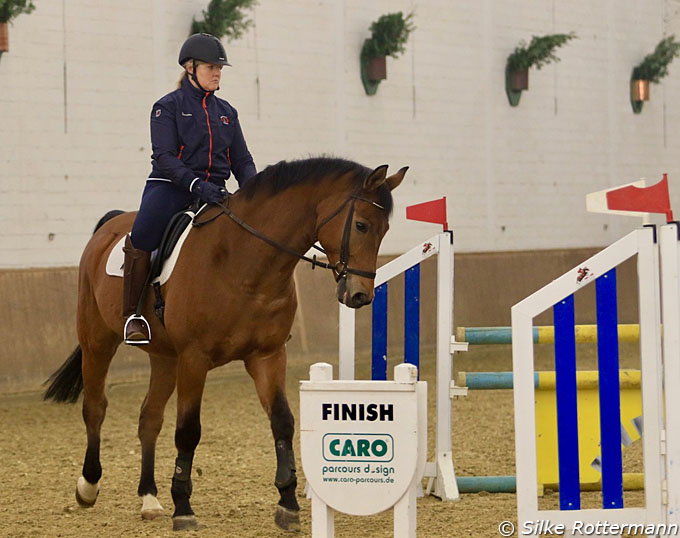
used to keep a horse entertained and
attentive during the warm-up phase in walk.
With every horse, but especially with a new horse you always want to start with the basics in order to find a good communication with them. On this first day the main goal was to get a feeling for the horses and have them relaxed and focused, in a good frame and balance. So we started with large serpentines and circles in trot. These help the horse to relax and creating and maintaining suppleness becomes easier. In trot there is no point to just trot around, because this makes the horse tired more easily, and it is better to make the work interesting and gymnastic for the horse. We checked that the horses were listening to the half halts and that it was possible to vary the trot between slightly collected and working trot. We used transitions between gaits and inside the gaits and some lateral work to get a good feeling on the first day.
Second Day: Focusing on Transitions
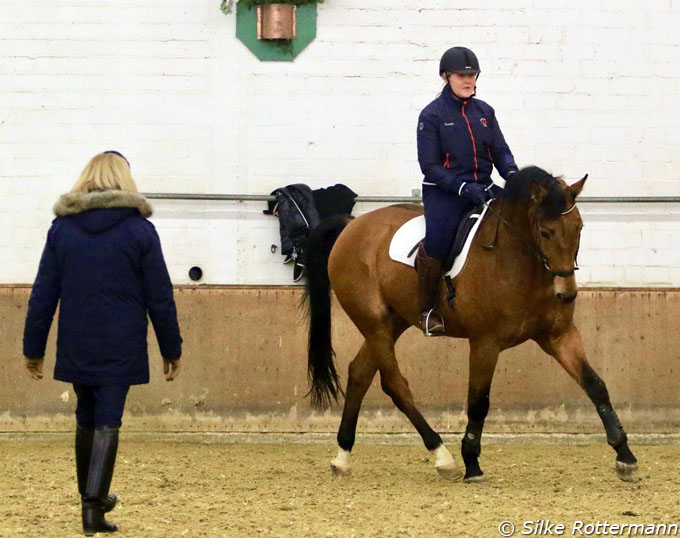
helps the horse to relax.
After that we worked a little on flying changes and the collection of canter, testing different ways to introduce these exercises to the horse. We started with the 5 meter - loops along the centerline with simple changes of leg while crossing the centerline. Afterwards we included a flying change in between. Most important was the fact that the horse kept a good quality of the canter and clear suppleness. Afterwards we executed the flying change on the long and short diagonal, always at unexpected points, to keep the horse more quiet.
Both horses found it easy to collect and the variety of exercises gave me many ideas to use back home. We worked also on the turn on the haunches, combining shoulder in into preparation which makes it easier for the horse to do the movement correctly and remain soft yet active.
Third Day: More Precision
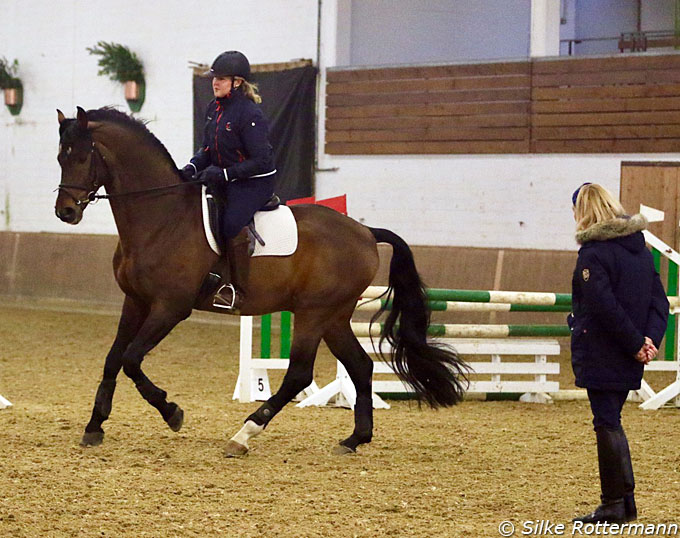
So on the third day we started to work more with precision, and exercises were done in a way as they would be presented on a competition arena. Because to prepare a horse well for competition means that this precision needs to be a daily routine as the horse needs to know what is expected of him. But routines are also most important for the rider. There should be a clear idea in the rider’s head what he wants to do and for which reason. This reason should not only be that a certain movement is required in a certain dressage class. All movements are developed to give gymnastics to the horse and to prepare the horse for the next task. The routines help to progressively improve the daily work and take good care of the basics. If something is failing, get back to basics, check straightness, let the horse relax a bit or get some activity in the movement, depending on the situation.
Today we continued with lateral work – shoulder in, travers and half-passes. For these it is beneficial to use 10 metres- circles for preparation. The bending that is created on the circle makes the start for the required movement easier for the horse. If there are difficulties, aim for a few good steps and prepare again. If you do less, but well, it will get easier soon.
Fourth Day: Independent Hands
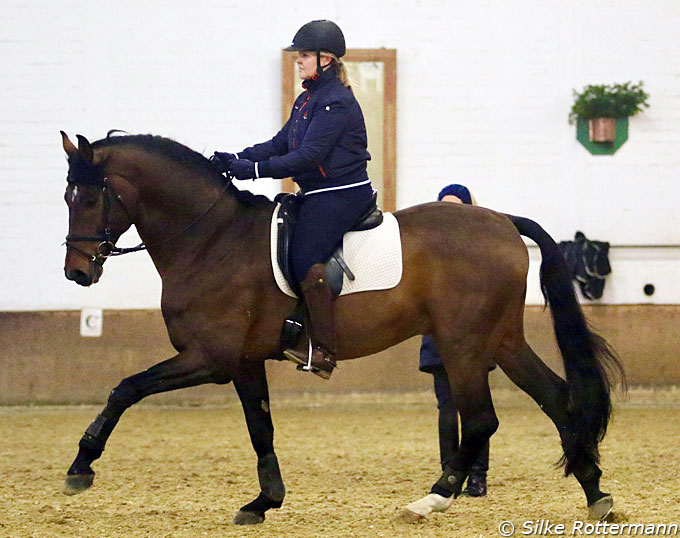
The rider is allowed to play with the fingers by closing and relaxing the hand that holds the inside rein, and when the horse relaxes, the hands remain silent near the withers. Sometimes it is useful to give and retake just only the inside rain to be sure that the rider doesn’t block with the inside hand the inside hind leg of the horse. There is always dominating the idea of driving the horse with the inside leg onto the outside rein.
A good way to create a more relaxed rider’s hand is to think the little fingers slightly closer to each other with the thumb laying with a light, not cramped angle on the closed fist. This tiny movement helps the rider to relax the wrist joint and the arm more easily.
We continued on collection to prepare the horse for quarter and half-pirouettes, using a square figure from the track to the centre-line and back (2 corners on the track, 2 on center line). We first introduced the exercise for the horses in walk, then in canter. Shoulder- in was again part of the preparation, and the idea was to collect the horse only two or three steps or strides to an increasing degree before coming into the corner to turn. Collection for a pirouette in walk and the quarter of a canter pirouette should only be done for two well collected steps or strides at this point. We also continued to collect both horses on a circle, using variation between collected and working canter on a smaller circle by asking travers and on. larger circle shoulder- in.
Fifth Day: Putting Theory into Practice
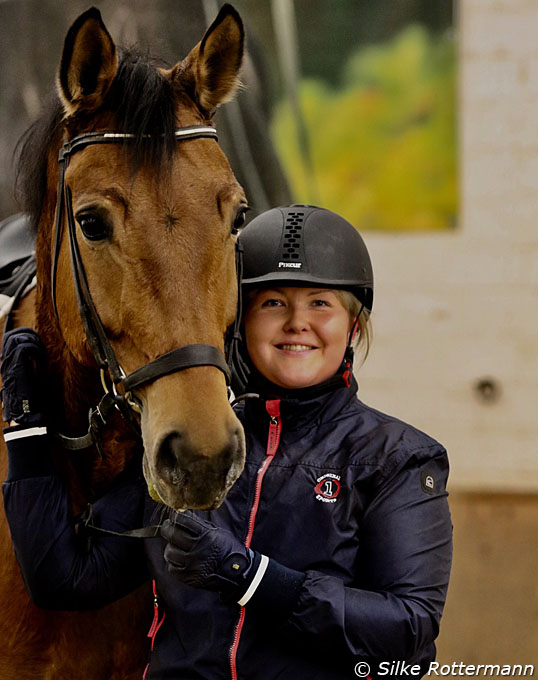
training sessions at the German Riding School
Training with Mrs. Frömming was a both an honour and a pleasure, as she has the skill to be extremely precise and insistent and at the same time keeps a very positive atmosphere on everything that is done. There has been more than just one moment when her strict voice dissolved in a loud laughter that gave some relief to the rider that she wouldn’t loose her sense of humour.
To have had the opportunity to train with somebody so classically schooled and with the incorruptible eagle eye of a judge, gives you the motivation to continue looking for the decisive details in equitation which can easily be overlooked in the quest for dressage movements, but which decide their quality.
As Warendorf now becomes more acquainted to me, I hope it was not my last visit to this charming little town that holds so much for riders and horse lovers alike.
Thank you Mrs. Frömming for your patience and pedagogy, thank you Hannes Müller for committing yourself to enable me this educational week and last not least thank you to the two fantastic and patient boys on four legs, „Keks“ and „Flashdance“.
By Niina Kirjorinne - Photos © Silke Rottermann
Related Links
Meet Niina Kirjorinne, Classical Dressage Rider and Physiotherapist
Functionality in Equitation: Skin Damage from Leg Aids
Angelika Fromming: Half a Century of Dressage
The Good Old Times?
Fromming & Stammer Seminar 2016: A Get-Together of Biomechanics and Classical Dressage Training
Fromming Stresses Objectivity at 2012 Portuguese Judging Clinic